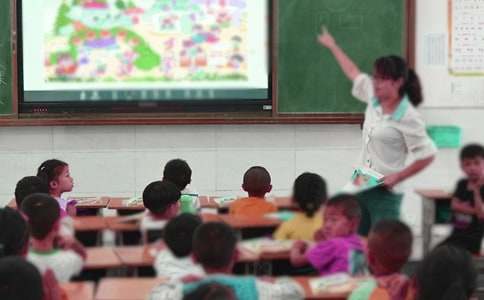《Travel plans》教學(xué)設(shè)計
一、教材內(nèi)容分析

本課時的教學(xué)內(nèi)容為新起點英語四年級下冊P24,即A Look, listen and repeat, B Let’s play, C Let’s write. A部分借助對話錄音和圖片呈現(xiàn)八個目標(biāo)詞匯:sea, ski, eat seafood, visit the Mogao Caves, West Lake, row a boat, the Great Wall, take photos,并通過讓學(xué)生看、聽、說、做等途徑來感受并學(xué)習(xí)這些詞匯。B部分通過“小導(dǎo)游”游戲,幫助學(xué)生操練詞匯,并體會詞匯在交際情景中的運用。C部分為讓學(xué)生根據(jù)所給的信息提示,選擇本科所學(xué)詞匯或運用已學(xué)詞匯完成句子填空,同時強化良好的英文書寫習(xí)慣。
二、學(xué)生情況分析
四年級的學(xué)生通過第一單元的學(xué)習(xí),學(xué)習(xí)了restaurant, post office, bank, grocery, crossroads等表示場所和地理位置的詞匯,為這節(jié)課的順利學(xué)習(xí)打下基礎(chǔ)。
三、教學(xué)目標(biāo)
通過本節(jié)課的學(xué)習(xí),學(xué)生能夠達到以下目標(biāo):
1. 能夠聽懂、會說 sea, ski, eat seafood, visit the Mogao Caves, West Lake, row a boat, the Great Wall, take photos等描述旅游景點名稱及相關(guān)活動的單詞和短語;能夠根據(jù)語境恰當(dāng)使用它們,并能借助拼讀規(guī)律認(rèn)讀、識記單詞和短語。
2. 能夠用We can … 初步表達在風(fēng)景名勝中所從事的'相關(guān)活動。
3. 能夠根據(jù)實際情況,選擇本課所學(xué)詞匯或運用已學(xué)詞匯完成句子填空,同時強化良好的英文書寫習(xí)慣。
4. 能夠通過課堂交流,了解在風(fēng)景名勝所能從事的活動,拓展視野。
四、教學(xué)重難點
教學(xué)重點:
能夠聽懂、會說sea, ski, eat seafood, visit the Mogao Caves, West Lake, row a boat, the Great Wall, take photos等描述旅游景點名稱及相關(guān)活動的單詞和短語;能夠根據(jù)語境恰當(dāng)使用它們,并能借助拼讀規(guī)律認(rèn)讀、識記單詞和短語。
教學(xué)難點:
能夠用We can … 初步表達在風(fēng)景名勝中所從事的相關(guān)活動。
五、教學(xué)步驟
1. 熱身(唱一唱)
T: Good morning, boys and girls.
Ss: Good morning, Miss Fan.
T: Do you like playing games?
Ss: Yes!
T: Let’s play Bomb games.(點擊課件)
設(shè)計意圖:通過玩炸彈游戲復(fù)習(xí)以前學(xué)習(xí)過的表示地點場所的名詞,激活學(xué)生以往的知識,同時在緊張愉快的氛圍中讓他們迅速進入學(xué)習(xí)英語的狀態(tài)之中。
T: Look! The train is coming. I say park, you say …, he says … Are you clear?
Ss: Yes!
T: Let’s play.
設(shè)計意圖:進行頭腦風(fēng)暴活動,激發(fā)學(xué)生頭腦中已有的關(guān)于此類話題的單詞。
T: What can you do in a park?
S: I can play ping-pong.
S: …
T: Let’s work in 2.
Ss: 學(xué)生兩人一組展開對話,班內(nèi)展示,及時評價。
設(shè)計意圖:復(fù)習(xí)由單詞過渡到句子。復(fù)習(xí)I can …功能句,為本節(jié)課的學(xué)習(xí)做好鋪墊。
2. 學(xué)習(xí)(學(xué)一學(xué),練一練)
(1)單詞教學(xué)
①教學(xué)eat seafood
T: Look!(點擊課件)Andy and Lily are enjoying the pictures. What places are they?
S: …
T: Have you ever been to these places for travelling?
S: …
T: Today we are going to talk about travel plans. Travel means 旅游, Plan means計劃,/’tr?vl/, /pl?n/.
Ss: /?tr?vl/ /pl?n/
T: Great! What do the two as say?
S: They say /?/.
T: Well done. Look at the beautiful pictures. Where is it?
Ss: Sanya.
T: Right! What can you do in Sanya?
S1: I can swim in the sea.
T: We can swim in the sea. I like the sea. What can we do by the sea?
S1: We can walk/ …
T: Do you like eat seafood? Look here! They are seafood. What does seafood mean?
Ss: It means 海鮮。
T: The food comes from the sea. We can eat seafood by the sea.
設(shè)計意圖:sea, seafood單詞比較簡單。主要是運用。
②教學(xué)ski
T: Look at the beautiful pictures. Where is it?
Ss: Harbin.
T: What can you do in Harbin?
S: We can …
T: Look here! What can he do? He can ski, /ski/.
Ss: /ski/
T: Do you like skiing?
Ss: Yes.
T: What else can you do in Harbin?
S: We can see the ice engraving.
T: Great!
設(shè)計意圖:激活學(xué)生已有的知識和生活經(jīng)驗。
③教學(xué)the Great Wall和take photos
T: Where is it?(點擊課件)
Ss: 北京
T: What can you do in Beijing?
S1: I can visit Tianmen Square.
S2: I can visit the Summer Palace.
S3: …
T: Good job! Look! Where is it?
Ss: 長城
T: The Great Wall. eat—great, all—wall.
Ss: The Great Wall.
T: Have you ever been to the Great Wall?
Ss: Yes. / No.
T: The Great Wall is great. What can we do on the Great Wall?
Ss: We can climb the hills.
T: What else?
S: We can see the flowers.
T: Can we take photos there?(做動作)
Ss: Yes!
T: take photos.
Ss: take photos
T: Where can we take photos?
S: We can take photos …
設(shè)計意圖:培養(yǎng)學(xué)生說的能力。將以前學(xué)習(xí)的場所單詞和這節(jié)課學(xué)習(xí)的做的事情有機結(jié)合起來。
④教學(xué)visit the Mogao Caves
T: Have you ever been to there?(點擊課件,出現(xiàn)敦煌景色圖片)
Ss: Yes. / No.
T: Where is it?
Ss: Dunhuang.
T: What can you visit in Dunhuang?
S: We can eat good food.
S: We can …
T: Excellent. What is it?
Ss: 莫高窟
T: It’s the Mogao Caves, /keivs/.
Ss: /keivs/
T: We can visit the Mogao Caves in Dunhuang. What else can we do in Dunhuang?
S: We can take photos in Dunhuang.
S: We can …
設(shè)計意圖:培養(yǎng)學(xué)生說話的能力。
⑤教學(xué)West Lake和row a boat
T: There is a nice place in Hangzhou. Many people visit it. Many poets wrote poems about it. Sushi thought it is as beautiful as Xizi. What is it?
Ss: 西湖
T: Yes, it’s the West Lake. What does a-e say?
Ss: /ei/
T: Good! /west/, /leik/.
Ss: /west/, /leik/
T: What can you do on West Lake?
S: I can take photos.
S: I can …
T: Can you row a boat?(做動作)
Ss: Yes.
T: /r??/
Ss: /r??/
T: /b??t/
Ss: /b??t/
T: You can row a boat on West Lake. Where can you row a boat?
S: I can row a boat …
設(shè)計意圖: 通過追問,培養(yǎng)學(xué)生綜合運用語言的能力。
⑥Look, listen and repeat
T: Look at the pictures! Let’s say by using This is … We can … Please work in 2.
學(xué)生兩人一組操練,班內(nèi)展示,及時評價。
T: Open you book. Listen and number.(點擊課件)
學(xué)生聽音標(biāo)號。班內(nèi)校對,及時評價。
設(shè)計意圖:讓學(xué)生先說再聽,一則是復(fù)習(xí)鞏固了新學(xué)習(xí)的單詞,二則是進行了聽前預(yù)測。
T: Let’s listen and finish the chart.(點擊課件)
學(xué)生聽音,完成表格,班內(nèi)校正,及時評價。
T:(點擊課件,出現(xiàn)文本)Let’s listen and repeat.
學(xué)生聽音跟讀,班內(nèi)展示,及時評價。
(2)Let’s play
T: Let’s play. First let’s see how to play.(點擊課件)
學(xué)生觀看
T: Are you clear?
Ss: Yes.
T: Let’s go. Work in 2.
Ss:學(xué)生兩人一組問和答,班內(nèi)展示,及時評價。
(3)Let's write
T: Look at the pictures.(點擊課件,出現(xiàn)A部分圖片)We can eat seafood in Sanya. What can you do?
S: We can …
設(shè)計意圖:說是為寫作鋪墊。
T: Now let’s write.
(4)Homework
1. Read the words to your parents.
2. Repeat the dialogue to your parents.
3. Write about your travel plan: We can … in …
設(shè)計意圖:家庭作業(yè)以說為主,檢測學(xué)生是否真正掌握本節(jié)課的內(nèi)容。作業(yè)實行分層,讓孩子根據(jù)自己的學(xué)習(xí)能力選作,真正實現(xiàn)了以生為主。
六、板書設(shè)計
整個板書以本節(jié)課的教學(xué)重難點為主,輔之以教學(xué)評價。老師每教授一個單詞就板書一個單詞。隨著教學(xué)的深入開展,接著在單詞旁邊添加單詞或者標(biāo)點符號,使之成為句子。評價是這樣進行的:全班分成AB大組比賽,比賽為爭奪小紅旗,看誰得到的小紅旗最多。最后用這個板書來進行整節(jié)課的小結(jié)。
【《Travel plans》教學(xué)設(shè)計】相關(guān)文章:
travel的造句04-11
travel的用法10-08
旅游 Travel10-19
autumn travel01-19
旅行 travel11-17
計劃與愿望 Plans and intentions11-17
travel可數(shù)嗎07-29